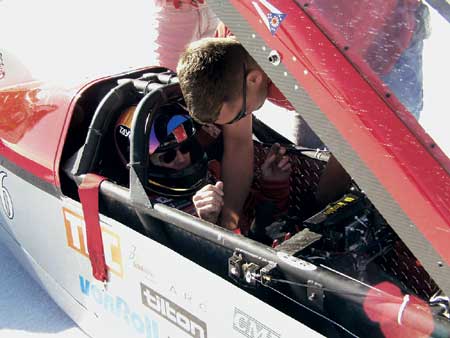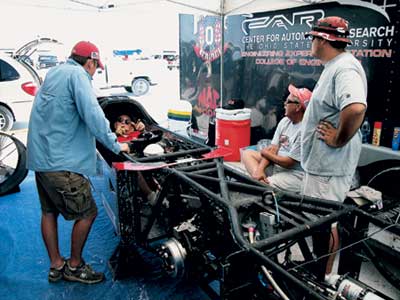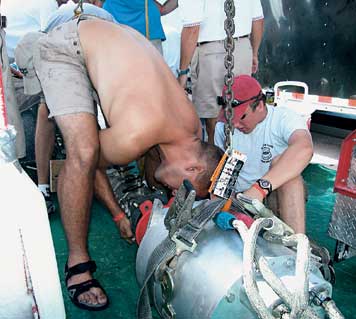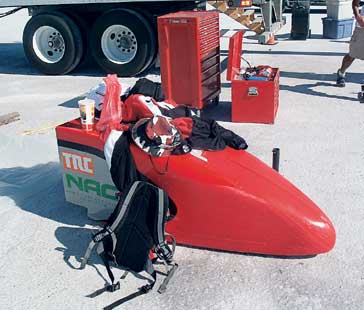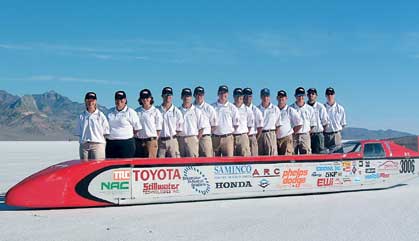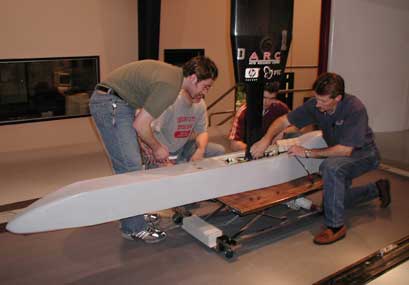The Buckeye Bullet
At the Utah’s Bonneville Salt Flats each year hundreds of vehicles of every description thunder across the vast plain in an effort to set a land speed record. In October 2004 one of those vehicles was the Buckeye Bullet, an electric streamliner created by a team of students from Ohio State University.
At the Utah’s Bonneville Salt Flats each year hundreds of vehicles of every description thunder across the vast plain in an effort to set a land speed record. In October 2004 one of those vehicles was the Buckeye Bullet, an electric streamliner created by a team of students from Ohio State University.
The Bonneville Salt Flats is a white salt plain spread across 30,000 acres in Utah, 90 miles from Salt Lake City and smack in the middle of the Wild West. Bonneville’s flat packed salt surface makes it an ideal place to stage a speed race, to let the horsepower out of the barn, to see just how fast fast can be.
Which is exactly what a team of undergraduate students from Ohio State University (OSU) were doing when they went west with their Buckeye Bullet, a battery-powered electric “streamliner,” for the annual World Finals in October 2004. And they went home with a fistful of new speed records to their credit.
The road to Bonneville has been a long one, says Giorgio Rizzoni, director of the Center for Automotive Research (CAR), an interdisciplinary research center in the college of engineering at OSU. The Bullet is a student project housed at CAR.
“This started 10 years ago when the Cleveland electric utility company launched a competition among universities to race electric cars,” Rizzoni says. The competition became the “Formula Lightning” (FL) series, and OSU students won several national championships with their Lightning car, the Smokin’ Buckeye. “But,” says Rizzoni, “after a few years, the students asked if we could do something different. They discovered there were electric classes for land speed records, and they said, ‘Why don’t we take what we’ve learned from this FL series and build the fastest electric car on earth?’”
The car they wanted to build was an electric “streamliner,” the name given to a class of long, skinny land speed vehicles recognized by organizations such as the International Federation of Automobiles and the Southern California Timing Association – the organization involved in timing land speed record races at Bonneville.
What came next was a year dedicated to building the concept and designing the car – and also raising funds and finding partners. Then there were two years spent building the vehicle and figuring out how to manage 400 horsepower, potential speeds in excess of 300 miles per hour and something like 4,000 pounds of flying machine.
“Going step by step was the secret,” says student team leader Isaac Harper. “We didn’t go out there [on the first run] and go 300 miles an hour,” he says. “We did it in increments, so we could test the transmission and the suspension and things like that. Each time we went faster, we came up with new problems. For instance, the first time we went over 300 miles an hour we noticed that the tires started to heat up and blister, and actually come apart from the centrifugal force. We began shaving off excess rubber so the heat could dissipate more quickly.”
The team made a first trip to Bonneville in October 2002 just to see what the Bullet could do. “The vehicle got up to around 240 miles per hour,” Rizzoni recalls, “which meant the concept worked, so we were all very excited.”
Racing on the Bonneville Salt Flats is unlike most auto racing. For one thing, each vehicle makes its run alone. “It’s a race against time, not a race against other vehicles,” Rizzoni explains. The course is five miles long and speeds are averaged for each of the final three miles, using the entrance and exit speeds of that mile. “Our U.S. record currently stands at just under 315 miles per hour, which is the average over the fifth mile and over two runs,” he says. The second run is required to establish a record speed.
Rizzoni points out that the actual speeds achieved can be much greater than the record-breaking speed. In addition to the other speed measurements taken each run, two instantaneous speed measurements are also taken, at the entrance to the third mile and at the exit at the fifth. “The exit speed at the end of the fifth mile is the highest speed,” says Rizzoni. At the exit of the fifth mile on one of the Bullet’s two runs in October 2004, the vehicle was actually traveling almost 322 mph. “Until that time, the fastest instantaneous speed of any electric vehicle ever recorded was 320 miles per hour,” he says. “That was the French TGV [Train à Grande Vitesse], the high-speed electric train.”
In its 2004 Bonneville session, the Bullet also broke the international speed record, albeit with a slower speed than some of its other runs. International rules require that speed is measured over a “flying kilometer” – a shorter distance than the “flying mile” of U.S. rules – and that the two runs be completed in opposite directions within 60 minutes instead of the four hours allowed in U.S. rules. “That makes it more difficult,” says Rizzoni. “First of all, it takes two or three miles to stop these vehicles. So then you have to bring the vehicle back to some new designated starting point and you have to repack the parachutes [mandatory for slowing the vehicle], which could take as much as 50 minutes, and you have to make sure that everything else is working. Plus, since the energy in the batteries is not enough to do two runs, you have to do some recharging as well – all in an hour. It’s a pretty tall order.”
On October 13, in the Bullet’s record-breaking two runs, the team managed to accomplish everything in 57 minutes, recording an average speed of 271.737 mph. The previous record was 245 mph. It was a respectable gain.
The Bullet’s chassis was designed around its roll cage, which in turn was designed around the previous driver Craig Taylor, a veteran race driver and a long-time adviser to the Bullet project. Taylor was only 5’2″. His replacement, Roger Schroer, is 5’11″. “Luckily,” says Harper, “Schroer was able to drive the car with his knees up by his chest, and we were able to make a new seat for him, but the whole cockpit compartment is very, very tight.”
Now, with the 2004 season over, the Bullet team is looking to the future. “We’ll be coming back in August 2005 with the same car, just modified slightly,” says Harper. “We’re hoping for 330 to 335 miles per hour, something like that – a performance gain of something like 15 to 25 miles per hour, and we’re looking to push the international record above 300.”
But before the team can go to the 2005 races, there’s a parachute problem to fix and ongoing work on improving the battery system. “We were very successful with the batteries this past year, but there was a tendency for them to overheat,” he says. “For the international record, you have only an hour to cool the batteries and charge them. So either we raise enough money to buy a second battery pack [at a cost of $35,000] so we can switch them in and out, or we develop a better cooling system.”
One thing that would help would be increased corporate sponsorship. “There are better and lighter batteries out there,” Harper says, “but their cost is out of reach for the project at this point. We’re always looking for new sponsors.”
Including Harper, the Bullet team currently has 15 members, all undergraduate students at the university. Harper, 21 and a junior in mechanical engineering, expects to have another two years with the team before he graduates.
“The project has taught me a lot about technical things and engineering, but more important it’s taught me leadership skills and the value of teamwork,” he says. “Every success I have from now on I’ll be able to directly look back and see the influence the Bullet project has had.”
The Buckeye Bullet fast facts:
U.S. record: 314.958 mph
International record: 271.737 mph
Instantaneous speed: 322 mph


